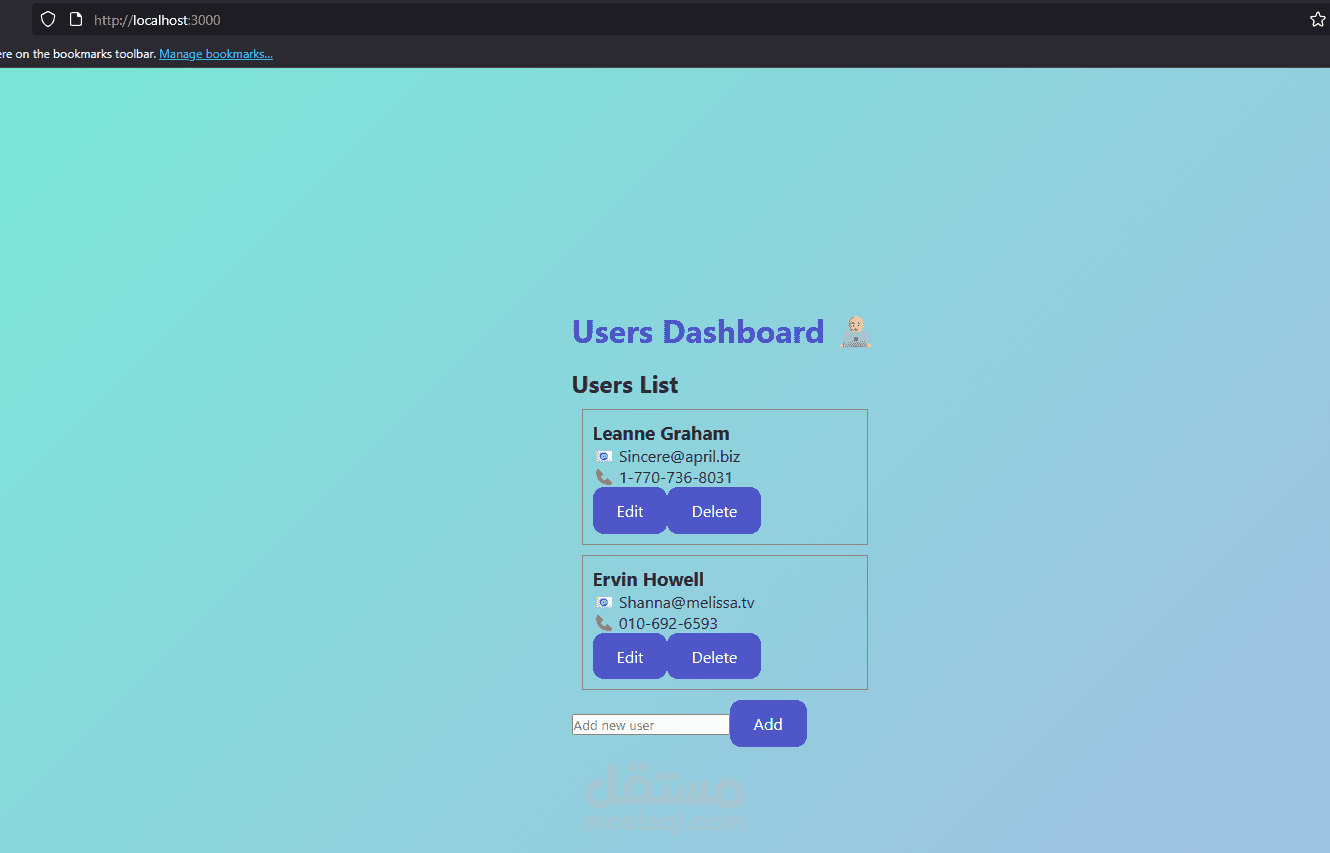FullStack-App
تفاصيل العمل
Users Dashboard Fullstack App
This repository contains two frontend implementations along with a FastAPI backend:
Integrated Frontend → React frontend fully integrated with the FastAPI backend.
Public API Frontend → React frontend that fetches data directly from a public API without using the backend.
Users can view, add, update, and delete users in the integrated version. The public API frontend only fetches and displays user data.
Frontend
The frontends are built with React and Context API for state management (for the integrated version).
Integrated Frontend Features
Display a list of users from the FastAPI backend
Add new users
Update existing users
Delete users
State management with UserContext
API integration using fetch
Public API Frontend Features
Fetches and displays users from a public API
No add/update/delete functionality
No global state management (optional usage of local state)
Getting Started (React)
Go to the frontend directory:
cd react-frontend
Install dependencies:
npm install
Run the development server:
npm start
Open http://localhost:3000 to view the app.
Available Scripts
npm start → Run the app in development mode
npm run build → Build for production
npm test → Run tests
Backend
The backend is built with FastAPI and serves as an API for the integrated frontend.
Features
REST API with CRUD routes:
GET /users → Get all users
GET /users/{id} → Get a single user
POST /users → Add a new user
PUT /users/{id} → Update a user
DELETE /users/{id} → Delete a user
CORS enabled for React frontend
In-memory database (can be replaced with a real database)
Getting Started (FastAPI)
Go to the backend directory:
cd fastapi-backend
Install dependencies:
pip install fastapi uvicorn pydantic
Run the development server:
uvicorn main:app --reload
Open http://127.0.0.1:8000/doc... to view the interactive API documentation.
Folder Structure
project/
│
├── react-frontend/ # Integrated frontend with Backend(FastAPI)
│ ├── src/
│ │ ├── components/ # UserList, UserItem, UserDetails, AddUserForm
│ │ └── context/ # UserContext
│ │ └── App.jsx
│ └── package.json
│
├── public-api-frontend/ # Public API frontend
│ └── src/
│
└── fastapi-backend/
├── main.py # FastAPI app with all routes
└── requirements.txt
Frontend & Backend Integration (Integrated Version)
React frontend sends HTTP requests (fetch) to FastAPI backend.
Backend handles CRUD operations in memory and responds with JSON.
Frontend updates its state based on backend responses.
Use Network tab in browser DevTools to verify requests go to backend (not just UI changes).
Component Hierarchy & Workflow (Integrated Frontend)
1️⃣ Component Hierarchy
App → Main component that contains everything.
UserProvider (Context) → Stores user data and makes it available to all child components.
UserList → Fetches users from the backend and displays them.
UserItem → Represents a single user in the list.
UserDetails → Small component to display email and phone for a user.
AddUserForm → Form to add a new user.
2️⃣ Workflow / Data Flow
Initialization
App starts and initializes the Context that holds global user data.
Fetching Users
UserList requests user data from the backend (FastAPI) when it loads.
The returned data is stored in Context for global access.
Displaying Users
UserList reads users from Context and renders a UserItem for each user.
Each UserItem passes user details down to UserDetails to display email and phone.
Adding a User
AddUserForm collects new user info from the form.
The form updates the global Context → UserList automatically updates to show the new user.
Conditional Rendering
While loading or if there are no users, UserList shows appropriate messages like “Loading…” or “No users found.”
3️⃣ React Concepts in the Workflow
Concept How It’s Applied
JSX Writing components as a mix of JavaScript + HTML
State / useState Storing local or global data
useEffect Fetching data when a component loads
useContext Sharing data across components without excessive props
Props Passing data from parent → child
Lifting state up Child component (AddUserForm) updates parent/global state
Events Handling user interactions (typing, button clicks)
Lists & Keys Rendering users list efficiently
Conditional Rendering Displaying different UI based on loading or empty states
API Calls React communicates with FastAPI backend to fetch or update data
Notes
Integrated frontend requires FastAPI backend to function fully.
Public API frontend works independently and only reads data from a public API.
Backend uses an in-memory database, so all changes are lost on restart.
To make it persistent, connect FastAPI to SQLite, PostgreSQL, or MongoDB.
The integrated frontend uses Context API to share state globally and fetch for API calls.
